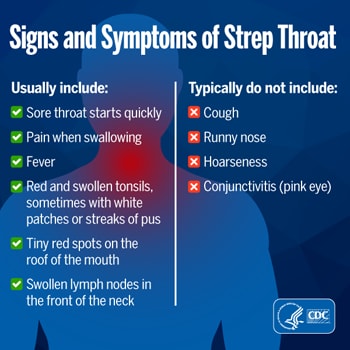Strep Throat: All You Need to Know

Worried your sore throat may be strep throat? Strep throat is a common type of sore throat in children, but it’s not very common in adults. Doctors can do a quick test to see if a sore throat is strep throat. If so, antibiotics can help you feel better faster and prevent spreading it to others.
On This Page
- Bacteria Cause Strep Throat
- How You Get Strep Throat
- Pain and Fever without a Cough Are Common Signs and Symptoms
- Children and Certain Adults Are at Increased Risk
- A Simple Test Gives Fast Results
- Antibiotics Get You Well Fast
- Serious Complications Are Not Common but Can Happen
- Protect Yourself and Others
Bacteria Cause Strep Throat
Viruses are the most common cause of a sore throat. However, strep throat is an infection in the throat and tonsils caused by bacteria called group A Streptococcus (group A strep).
How You Get Strep Throat
Group A strep live in the nose and throat and can easily spread to other people. It is important to know that all infected people do not have symptoms or seem sick. People who are infected spread the bacteria by coughing or sneezing, which creates small respiratory droplets that contain the bacteria.
People can get sick if they:
- Breathe in those droplets
- Touch something with droplets on it and then touch their mouth or nose
- Drink from the same glass or eat from the same plate as a sick person
- Touch sores on the skin caused by group A strep (impetigo)
Rarely, people can spread group A strep through food that is not handled properly (visit CDC’s food safety page). Experts do not believe pets or household items, like toys, spread these bacteria.
Pain and Fever without a Cough Are Common Signs and Symptoms
In general, strep throat is a mild infection, but it can be very painful. The most common symptoms of strep throat include:
- Sore throat that can start very quickly
- Pain when swallowing
- Fever
- Red and swollen tonsils, sometimes with white patches or streaks of pus
- Tiny, red spots (petechiae — pronounced pi-TEE-kee-eye) on the roof of the mouth (the soft or hard palate)
- Swollen lymph nodes in the front of the neck
Other symptoms may include a headache, stomach pain, nausea, or vomiting — especially in children. Someone with strep throat may also have a rash known as scarlet fever (also called scarlatina).
The following symptoms suggest a virus is the cause of the illness instead of strep throat:
- Cough
- Runny nose
- Hoarseness (changes in your voice that makes it sound breathy, raspy, or strained)
- Conjunctivitis (also called pink eye)
It usually takes two to five days for someone exposed to group A strep to become ill.

A sore throat that starts quickly, pain with swallowing, and fever are some of the common signs and symptoms of strep throat.
Children and Certain Adults Are at Increased Risk
Anyone can get strep throat, but there are some factors that can increase the risk of getting this common infection.
Strep throat is more common in children than adults. It is most common in children 5 through 15 years old. It is rare in children younger than 3 years old. Adults who are at increased risk for strep throat include:
- Parents of school-aged children
- Adults who are often in contact with children
Close contact with another person with strep throat is the most common risk factor for illness. For example, if someone has strep throat, it often spreads to other people in their household.
Infectious illnesses tend to spread wherever large groups of people gather together. Crowded conditions can increase the risk of getting a group A strep infection. These settings include:
- Schools
- Daycare centers
- Military training facilities
Strep Throat: More Common in Children
- Up to 3 in 10 children with a sore throat have strep throat
- About 1 in 10 adults with a sore throat has strep throat
A Simple Test Gives Fast Results
Only a rapid strep test or throat culture can determine if group A strep is the cause. A doctor cannot tell if someone has strep throat just by looking at his or her throat.
A rapid strep test involves swabbing the throat and running a test on the swab. The test quickly shows if group A strep is causing the illness. If the test is positive, doctors can prescribe antibiotics. If the test is negative, but a doctor still suspects strep throat, then the doctor can take a throat culture swab. A throat culture takes time to see if group A strep bacteria grow from the swab. While it takes more time, a throat culture sometimes finds infections that the rapid strep test misses. Culture is important to use in children and teens since they can get rheumatic fever from an untreated strep throat infection. For adults, it is usually not necessary to do a throat culture following a negative rapid strep test. Adults are generally not at risk of getting rheumatic fever following a strep throat infection.
Someone with strep throat should start feeling better in just a day or two after starting antibiotics. Call the doctor if you or your child are not feeling better after taking antibiotics for 48 hours.
Antibiotics Get You Well Fast
Doctors treat strep throat with antibiotics. Either penicillin or amoxicillin are recommended as a first choice for people who are not allergic to penicillin. Doctors can use other antibiotics to treat strep throat in people who are allergic to penicillin.
Benefits of antibiotics include:
- Decreasing how long someone is sick
- Decreasing symptoms (feeling better)
- Preventing the bacteria from spreading to others
- Preventing serious complications like rheumatic fever
Someone who tests positive for strep throat but has no symptoms (called a “carrier”) usually does not need antibiotics. They are less likely to spread the bacteria to others and very unlikely to get complications. If a carrier gets a sore throat illness caused by a virus, the rapid strep test can be positive. In these cases it can be hard to know what is causing the sore throat. If someone keeps getting a sore throat after taking the right antibiotics, they may be a strep carrier and have a viral throat infection. Talk to a doctor if you think you or your child may be a strep carrier.
Serious Complications Are Not Common but Can Happen
Complications can occur after a strep throat infection. This can happen if the bacteria spread to other parts of the body. Complications can include:
- Abscesses (pockets of pus) around the tonsils
- Swollen lymph nodes in the neck
- Sinus infections
- Ear infections
- Rheumatic fever (a heart disease)
- Post-streptococcal glomerulonephritis (a kidney disease)
Protect Yourself and Others
People can get strep throat more than once. Having strep throat does not protect someone from getting it again in the future. While there is no vaccine to prevent strep throat, there are things people can do to protect themselves and others.
Good Hygiene Helps Prevent Group A Strep Infections
The best way to keep from getting or spreading group A strep is to wash your hands often. This is especially important after coughing or sneezing and before preparing foods or eating. To practice good hygiene you should:
- Cover your mouth and nose with a tissue when you cough or sneeze
- Put your used tissue in the waste basket
- Cough or sneeze into your upper sleeve or elbow, not your hands, if you don’t have a tissue
- Wash your hands often with soap and water for at least 20 seconds
- Use an alcohol-based hand rub if soap and water are not available
You should also wash glasses, utensils, and plates after someone who is sick uses them. These items are safe for others to use once washed.

Wash your hands often to help prevent germs from spreading.
Antibiotics Help Prevent Spreading the Infection to Others
People with strep throat should stay home from work, school, or daycare until they:
- No longer have a fever
- AND
- Have taken antibiotics for at least 24 hours
Take the prescription exactly as the doctor says to. Don’t stop taking the medicine, even if you or your child feel better, unless the doctor says to stop.
Wash your hands often to help prevent germs from spreading.






















.png)











No hay comentarios:
Publicar un comentario